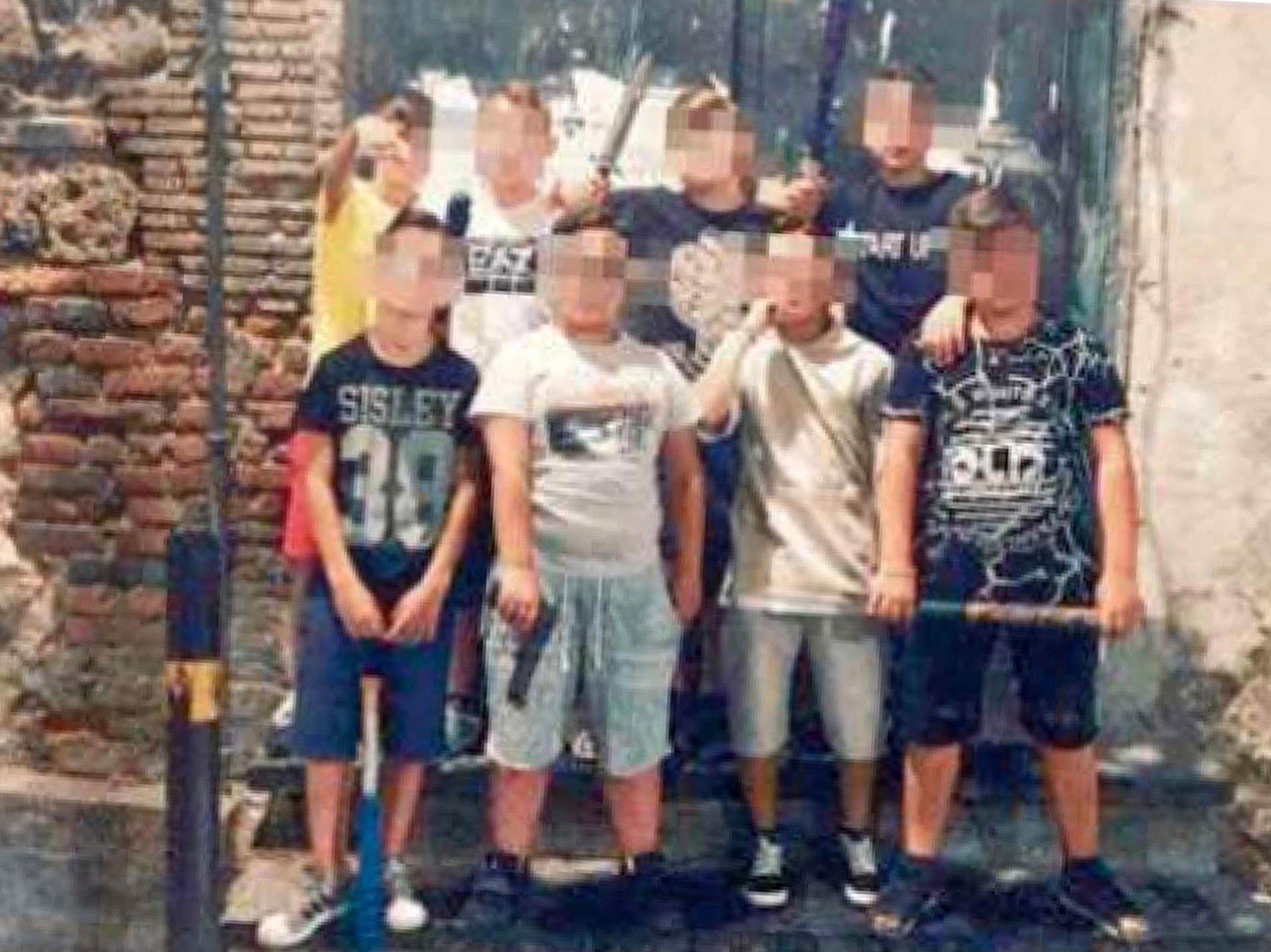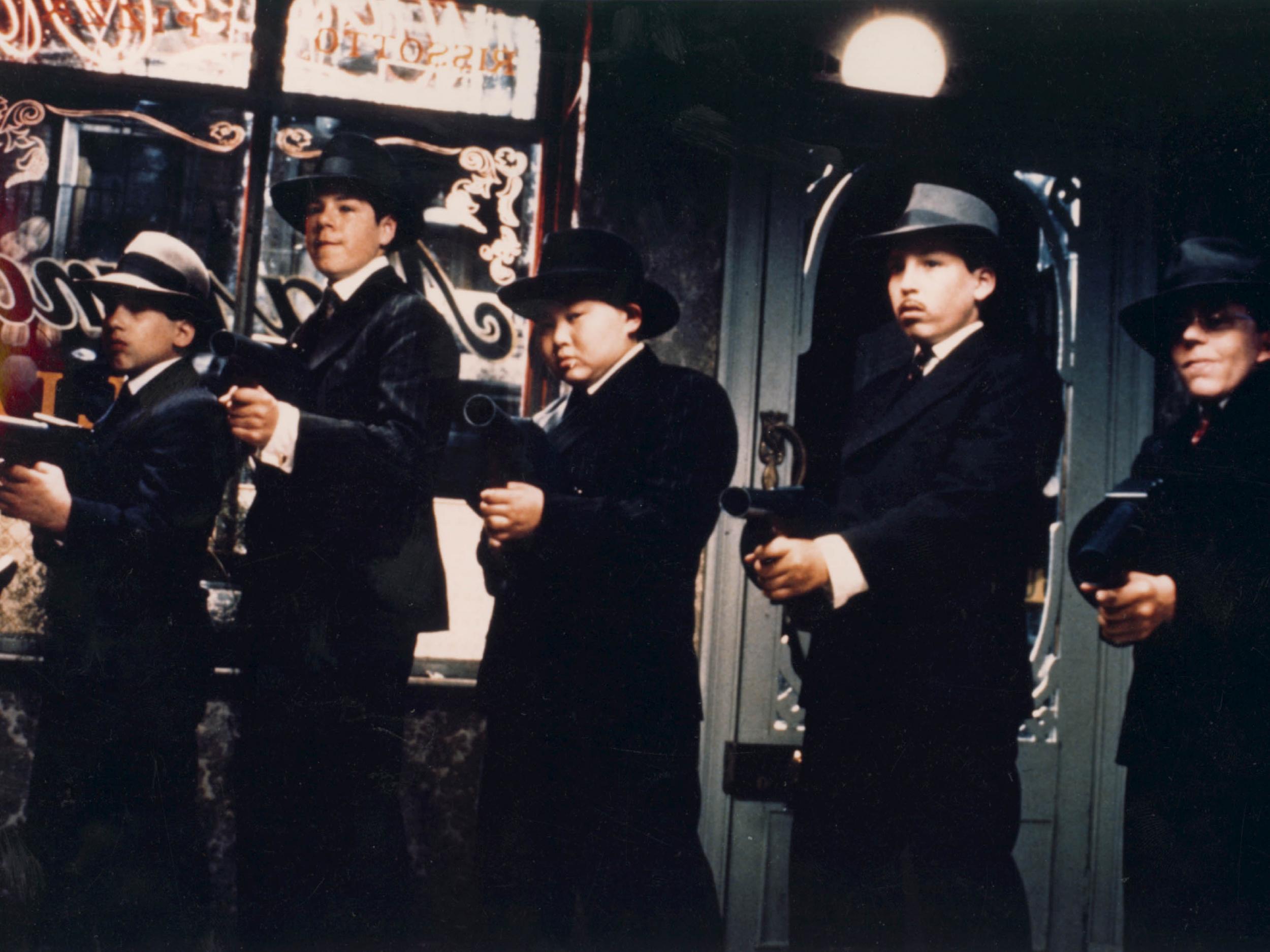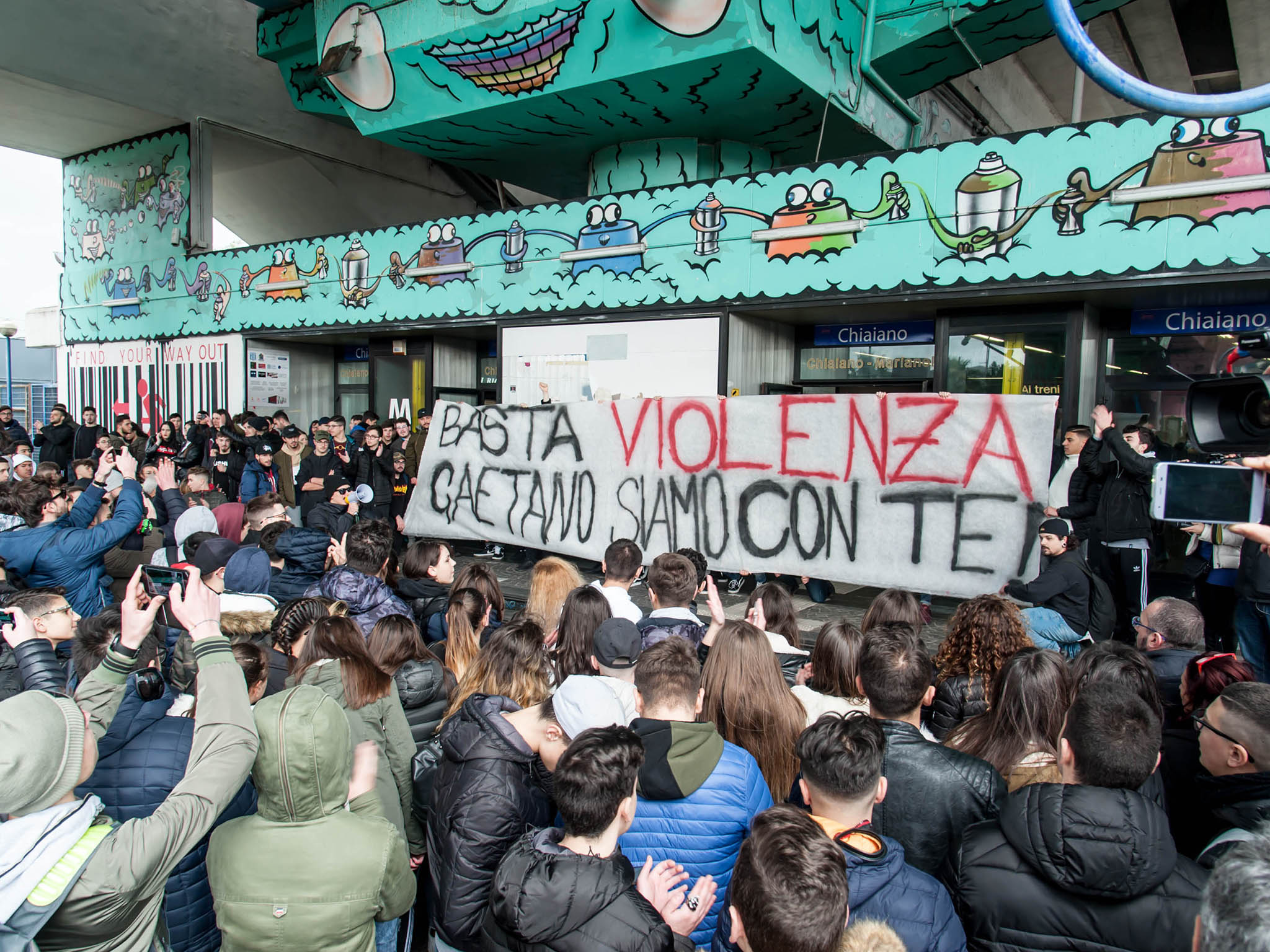‘Bambini del Diavolo’: How 12-year-olds are terrorising the streets of Naples
Barely pubescent, menacing gangs known to locals as ‘children of the devil’ have emerged from an era defined by economic crisis, says Paul Tierney


You hear them before you see them: a low, feral rumble rising to something shrill and uncomfortable. Lungs bellow for prominence, limbs kick and shove. Around the corner they emerge, tanned legs and bum-fluff moustaches, hormones not so much burgeoning as exploding into action. They are Naples’ I Bambini del Diavolo (IBDD), or The Devil Children, and they are 12 years old.
“These kids make a big problem for me,” complains Giuila Orfanelli, a waitress at Gran Caffe Gambrinus in the city’s well-heeled Chiaia district. “They buy one coffee each and make it last all night, and [are] always asking for endless glasses of tap water.” Signora Orfanelli is right to be aggrieved. Not only do they outstay their welcome, IBDD flick ash on the tables, blow smoke into the faces of hapless customers, and breathe new life into the antiquated term “juvenile delinquent”.
The silky haired girls are all Lolitas in the making, their denim shorts more cauterised than cut off. Boys appear circumspect and somewhat less convincing. A few loiter in designer streetwear, laughingly swamped in oversized T-shirts boasting Dsquared2 or Off-White logos. The more adventurous don mafiosa-style suits, aiming for power, but coming off like extras from Bugsy Malone.
They push each other into the road as if it were a form of affection, devour Kool cigarettes like Haribo and commandeer the pavement like a squadron of designer rug rats. “We call them the devil children,” says Orfanelli. “I won’t say they are evil, but they have no rules. It is sinful behaviour.”
I’m not sure if these smooth-skinned reprobates really care what God thinks. The church in Italy holds less sway here than it has ever done, and they, like the unpredictable government, are not alone in experiencing widespread public mistrust.
These barely pubescent kids, roaming the streets without purpose, are symptomatic of a malaise in Italian society; a throwback to Berlusconi’s dumbed down nod to America and a lazy, education-shunning culture which favours lire over learning.
Look at these gangs in the wrong way and the results can be devastating. Nihilistic attacks have resulted in multiple fatalities
At 18 per cent, Naples has one of the highest truancy rates in Europe, a fact not lost on those trying to control the melee. Local police struggle to keep order, prosecutors regularly jail young offenders – while only exacerbating the situation – and locals seem powerless and frightened of recrimination.
The problem stems from a population who live in silent fear of organised crime. In this part of Italy La Camorra, the powerful mafia syndicate responsible for countless indiscriminate murders, continues to exert an ugly grip on the lives of ordinary citizens.
“The System”, as identified by Roberto Saviano in his landmark book Gomorrah, is a pervasive influence in more ways than one. Not only do the Camorra rule by fear – the dark glamour that has emanated from the subsequent films and TV series also lures many vulnerable youngsters into their fold.
With most mafia bosses now in jail, vacant positions are taken by younger, more reckless members of the hierarchy, many of whom remain teenagers. In 2017, a spate of violent attacks in Naples identified the rise of the so-called baby gangs, a ruthless young knife culture that has its roots in mafia practice.
Look at these gangs in the wrong way and the results can be devastating. Nihilistic attacks, often on other young people, have resulted in multiple fatalities only adding to Naples’ depressing record of crime.

“We can clearly see the baby gangs are criminals, or people who want to have criminal careers,” says Felia Allum, author of The Invisible Camorra: Neapolitan Crime Families across Europe. “But there’s a vacuum, because the traditional families have lost their leaders. In the centre of Naples the bosses are either in prison or they’ve become state witnesses, so there’s this kind of space for younger kids to appear. They’re 17 or 18 with criminal ambition, and they’ve got a sense of identity of what they want to do.”
As a senior lecturer in politics and Italian at Bath University, Allum is well versed in the machinations of organised crime. She puts me in touch with Maria de Luzenberger, public prosecutor at the juvenile court of Naples, a woman who has seen a worrying rise in youth crime on her patch “It’s a cultural problem as much as anything,” she offers.
“Often parents don’t realise that a lack of rules can create deviant behaviour. But I think that in Napoli there is a big social problem too, made worse by economic crisis, and for young people this is a major risk factor. Even though juvenile crime is not exclusively Neapolitan, my opinion is that Napoli might be one of the cities where the problem is worse.”
Luzenberger receives reports of crimes by groups of underage children on a daily basis. “Those that are sued come mostly from poor neighbourhoods and families,” she says.
“They are kind of outcasts of society. Generally they quit going to school early and think that bullying and violence are the only ways to come out from a deprived condition. In other cases they come from families connected to organised crime and, so to speak, follow their relatives’ steps. I’ve never heard of them referred to as devil children. Are they a threat to society? Let’s say, this group of children can create discomfort for other citizens who mostly live according to different values.”
The mafia can give you money, they can give you cars, women, great clothes. You don’t need to study, you don’t have to focus on a career
It’s important to make the distinction between IDDB and the bloodthirsty baby gangs, but the transition from juvenile braggadocio to revenge killing is easy to navigate in this troubled city. The problem here is the alarming age at which it starts to root. When did children become such a menacing subsect? The ebullient attitude and ill-suppressed violence are fast becoming a national problem.
“It’s actually happening all over Europe,” says James Anderson, contributing editor at i-D magazine. “Put it down to the internet. Being exposed to life, in both its fabulous and gory extremes, does strange things to adolescent minds. The economy in southern Italy is in free fall, jobs are scarce. To be looked at, talked about, admired or vilified, it’s the classic way of “showing out”. Young people want to do things on their own terms and they are demanding your attention in ever more lurid ways.”
Fabio Immediato is a 27-year-old Neapolitan now living in London. As a senior fashion editor at Vogue India, he is well studied in the power of apparel. He also recognises that clothes mean more to Naples’ inhabitants than most. “It comes with the typical south Italian culture of wanting to show off, wanting to fare la bella figura (to always look good),” he says, “and to be part of a gang. There has always been a gang culture in southern Italy. You are always judged by what you are wearing. People scan you from head to toe.
“There is often a figurehead in these gangs – the so-called fighetto, the guy who dresses in labels, and in some ways it always relates to clothing. It’s a way of showing people how much money you’ve got, or what kind of class you belong to. Kids have to and want to belong to something, and the more popular the better.”
Although wholly dispassionate, Immediato admits that IBBD are vulnerable to organised crime. “La Camorra are shrewd. They know that children under 14 cannot be prosecuted to the same degree as an adult, and so target them to commit specific crimes. The mafia – and it’s very loose term – can give you money, they can give you cars, women, great clothes. You don’t need to study, you don’t have to focus on a career. This is how they start.”
And the motivation? “They are ruleless. They try to be, not anarchists, but to go against what society tells them to do at their age. It’s almost like they are antagonising what is happening in the country at the moment.”

Italy has a rich history of youth culture. Gangs of marauding teenagers have long gathered in the piazzas looking for kicks, and it’s mostly been tutto bene. In the mid-1950s, the young riviera set swooned to American jazz, the Milanese immortalised the humble cup of coffee, and Roman Holiday inspired a army of teenagers to hop onto scooters and circle the Colosseum.
The look was strong, neat and oh-so-Mod. Something “Made In Italy” could often make a young man’s day. By the mid-1980s, a scene had evolved in Milan which became known as “Paninaro” and centred around Burghy, an American fast food restaurant on Piazza San Babila.
Pre-McDonalds, Burghy had a distinctly fresh appeal, spawning a fashion-centric scene that developed in step with its capitalist aesthetic, imported US TV and the rise of spendy Reaganomics. Paninari were a new breed of label-obsessed teens in awe of Stateside culture, but equally smitten with the aspirational cut of their own high-octane designers.
There is safety in numbers, and this culture is all about safety in numbers
“The Paninari were considered quite annoying back in the day,” says Italian fashion critic Angelo Flaccavento. They were right-wing, kind of flashy, show-off people. This came right after the 1970s, which was a very left-wing political era, so kids were just signalling how rich their parents were by showing off what they could afford.”
As a Sicilian, Flaccavento can see the connection between clothes and gang culture: “It’s very Italian,” he smirks. “For the Paninaro it was all about clothing being a code that identified you as part of the gang. If you were an individual you would end up being sucked into the group anyway, and I think this is what is happening with I Bambini del Diavolo.”
We talk about how vulnerable the kids are, and how organised crime infiltrates every aspect of Italian life. On the day we speak, tragic news emerges about the bridge collapse in Genoa, a structure purportedly built with inferior Mafia-supplied cement.
“It’s a problem. In relation to youth crime, if you are telling me that the ‘devil children’ are wearing similar clothing, acting like they want to go incognito or undercover, it looks like they are doing something illegal and don’t want to be identified. There is safety in numbers, and this culture is all about safety in numbers.”
Everyone questions attributes a lack of education as the major factors generating this antisocial behaviour. Can this be the definitive reason? “Neapolitans are very resourceful,” says Felia Alum. “They live in the moment and on their wits. They’re laid back, but there’re also very bright and resourceful. If you live on your wits then education doesn’t seem so important because whatever happens will happen.”
“Naples feels like Pleasure Island in Pinocchio,” offers James Anderson. “The place where wayward boys go to smoke, drink and fight, where there’s no school and no law. There’s a character in the film who turns to Pinocchio and says: ‘Being bad’s a lot of fun, ain’t it?’” Who could argue with that?
Join our commenting forum
Join thought-provoking conversations, follow other Independent readers and see their replies
Comments